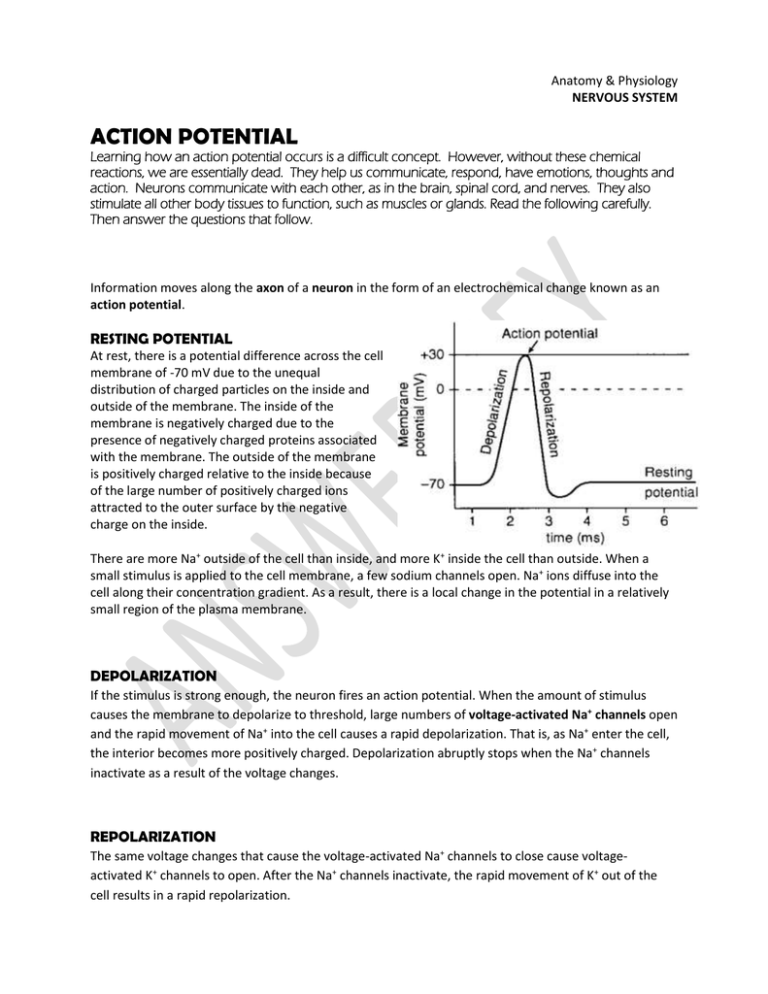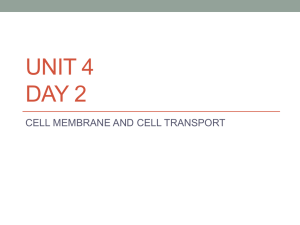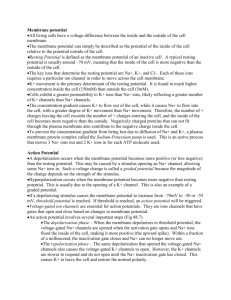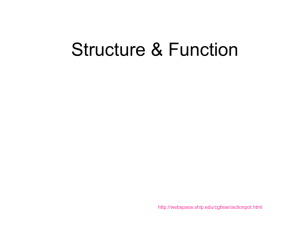Action Potential
advertisement

Anatomy & Physiology NERVOUS SYSTEM ACTION POTENTIAL Learning how an action potential occurs is a difficult concept. However, without these chemical reactions, we are essentially dead. They help us communicate, respond, have emotions, thoughts and action. Neurons communicate with each other, as in the brain, spinal cord, and nerves. They also stimulate all other body tissues to function, such as muscles or glands. Read the following carefully. Then answer the questions that follow. Information moves along the axon of a neuron in the form of an electrochemical change known as an action potential. RESTING POTENTIAL At rest, there is a potential difference across the cell membrane of -70 mV due to the unequal distribution of charged particles on the inside and outside of the membrane. The inside of the membrane is negatively charged due to the presence of negatively charged proteins associated with the membrane. The outside of the membrane is positively charged relative to the inside because of the large number of positively charged ions attracted to the outer surface by the negative charge on the inside. There are more Na+ outside of the cell than inside, and more K+ inside the cell than outside. When a small stimulus is applied to the cell membrane, a few sodium channels open. Na+ ions diffuse into the cell along their concentration gradient. As a result, there is a local change in the potential in a relatively small region of the plasma membrane. DEPOLARIZATION If the stimulus is strong enough, the neuron fires an action potential. When the amount of stimulus causes the membrane to depolarize to threshold, large numbers of voltage-activated Na+ channels open and the rapid movement of Na+ into the cell causes a rapid depolarization. That is, as Na+ enter the cell, the interior becomes more positively charged. Depolarization abruptly stops when the Na+ channels inactivate as a result of the voltage changes. REPOLARIZATION The same voltage changes that cause the voltage-activated Na+ channels to close cause voltageactivated K+ channels to open. After the Na+ channels inactivate, the rapid movement of K+ out of the cell results in a rapid repolarization. HYPERPOLARIZATION K+ channels open and close slowly. As a result, more K+ leave the cell than are necessary to repolarize the membrane. This causes a slight hyperpolarization called the after potential. Although the voltageactivated channels are closed, potassium leaks through other open channels to return the cell to the resting potential. RESTING POTENTIAL Shortly after the negative after potential occurs, the cell re-establishes the normal resting potential. The sodium-potassium pump acts to re-establish the original ion concentrations by pumping Na+ out and bringing K+ back in. A B At REST C SUMMARY An action potential is an electrochemical change that occurs along the length of a nerve cell's axon. It is initiated when a threshold stimulus is applied to the nerve cell. The stimulus causes large numbers of voltage-activated Na+ channels to open and Na+ to enter the cell, causing a rapid depolarization of the membrane. Inactivation of the voltage-activated Na+ channels causes the depolarization phase to stop abruptly. The voltage changes that occur during depolarization trigger the opening of voltage-activated K+ channels. The loss of K+ from the cell causes the membrane to repolarize. After the action potential is generated, sodium-potassium pumps in the cell membrane return the ions to their original locations. D KEY Name__________________________________________Per____Date______________ANAT & PHYS NERVOUS SYSTEM: Action Potential Answer the questions below. (See textbook pp. 399-404 for more information if needed.) 1. What is an ACTION POTENTIAL? An electrochemical change that moves information along the axon. 2. At rest, how do charges across the neuron membrane differ? The INSIDE has a - charge due to fewer K+ ions. The OUTSIDE has a + charge do to more Na+ ions. 3. A small stimulus causes Na+ channels to open. As a result, Na+ ions move INTO the cell. The Na+ ions move along their concentration gradient. This means that molecules move from an area of HIGH concentration to an area of LOW concentration. (This answer not found in the description. Think of what you learned about DIFFUSION in Biology!) How would the movement change the overall electrical charge on both sides of the membrane? The INSIDE becomes + The OUTSIDE becomes - Which picture (A, B, C, or D) shows this? B, C, D 4. What does the neuron do if the stimulus is strong enough? Fires an action potential along the axon 5. DEPOLARIZATION means there is an overall change in electrical charges across the membrane. What ions are responsible for this change? Na+ When do the channels for these ions close? When inside becomes + 6. What ion channels open during REPOLARIZATION? K+ Where do these ions move? (into the cell? Out of the cell?) Out of cell 7. 7. HYPERPOLARIZATION means the INSIDE of the cell becomes more What causes this to happen? K+ channels open and close slowly 8. After this, the inside of the cell has a - charge and the outside has a + charge, just as it did at rest. 9. However, the ion concentration has switched. This means that there are more Na+ IONS on the INSIDE and more K+ ions on the OUTSIDE. 10. To fix this, the sodium-potassium pump returns the membrane to RESTING POTENTIAL by pumping 3 Na+ ions OUT and 2 K+ ions IN. 11. Complete the chart. INSIDE OUTSIDE of membrane of membrane (electrical charge) (electrical charge) + or -- + or + DEPOLARIZATION + REPOLARIZATION RESTING POTENTIAL ACTION POTENTIAL RESTING POTENTIAL Na+ channels K+ channels OPENED or CLOSED? OPENED or CLOSED? Closed Closed -- Open Closed -- + Closed Open -- + Closed Closed







